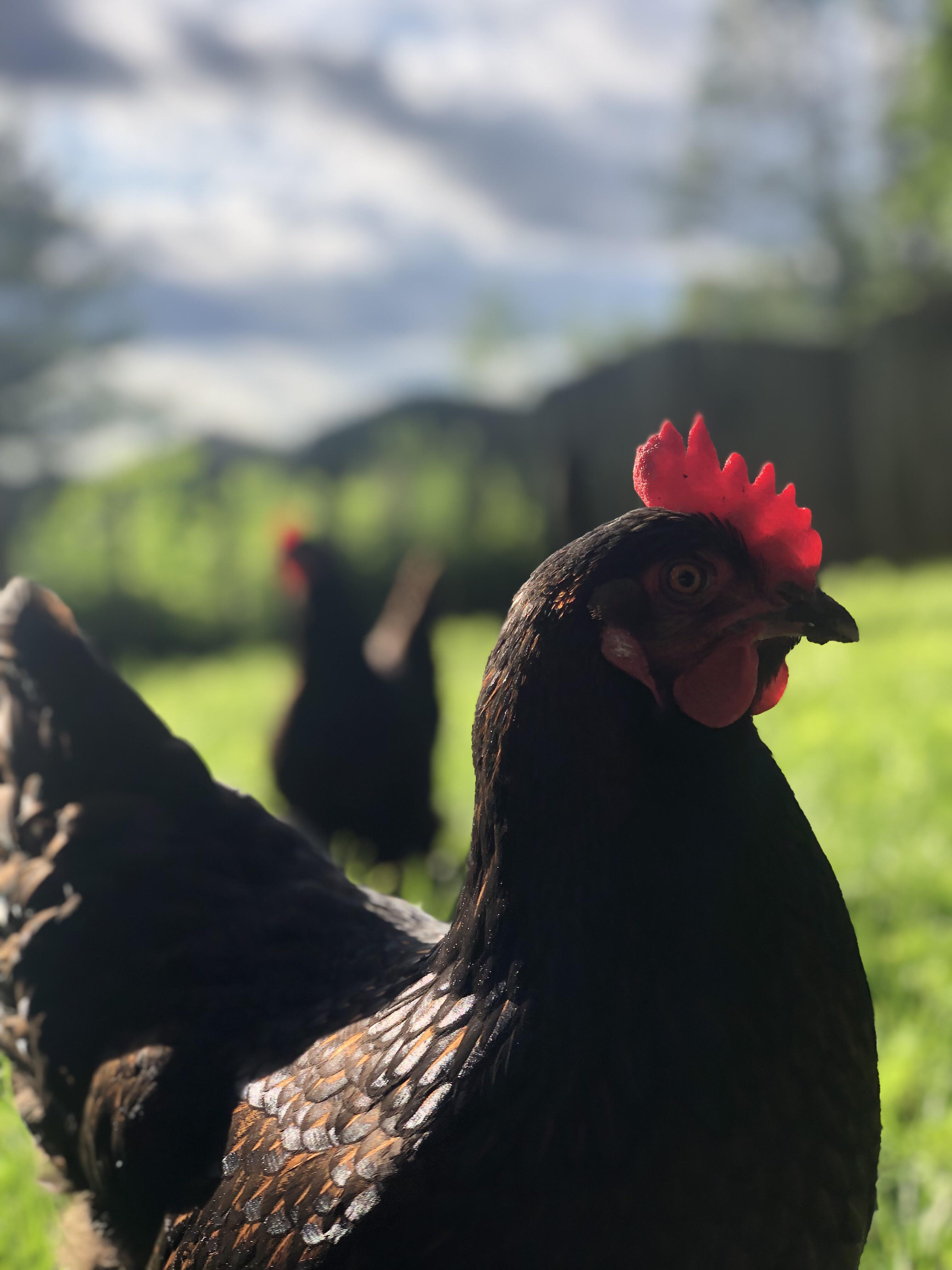The Barnevelder chicken breed is beloved for its beautiful feathers and decent egg-laying capabilities. So, adding some to your backyard might be beneficial.
This article will cover the history, appearance, and care requirements for this chicken breed to help you decide if these are the right chickens for you.
[toc]
Barnevelder Chicken Overview
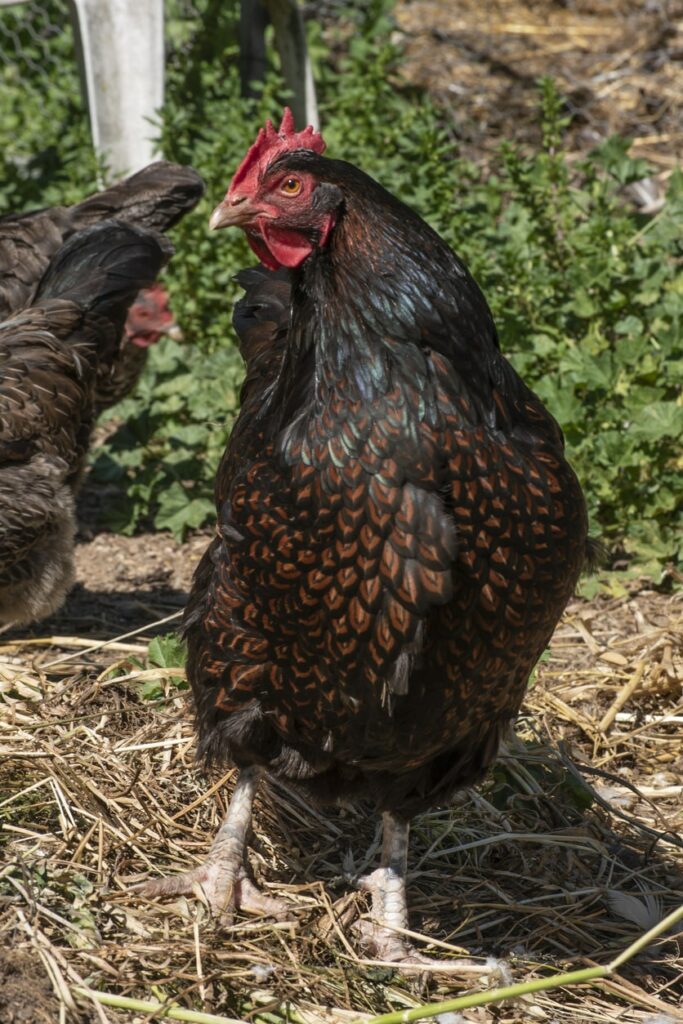
Before focusing on the specific details of Barnevelder chickens, let’s look at some quick facts about the breed.
| Lifespan | 7 to 11 years |
| Weight | 5 to 8 pounds |
| Appearance | Brown and black feathers in an arrowhead pattern |
| Egg Production | 3 to 4 per week, 150 to 200 annually |
| Egg Color | Chocolate brown |
| Good for Beginners? | Yes |
| Minimum Coop Size | 4 square feet per chicken |
| Price | $10 to $12 per chick |
Barnevelder Chicken History
The Barnevelder chicken is a newer breed, but its history is still a little unclear. It’s believed to have originated in the Dutch town of Barnevelder in the Netherlands, hence the name.
Many keepers believe that the Barnevelder was made by breeding a landrace bird with breeds like the Brahma and Cochin. The exact genetic mixture of this chickens is still up for debate. The town these chickens came from was known for supplying eggs, so they likely bred this breed for improved egg production.
The unique coloring of Barnevelder chickens was rarely seen in the early 1900s. It suggests that these chickens have some Indian Game genes in them to create the arrowhead pattern.
Barnevelder Chicken Appearance
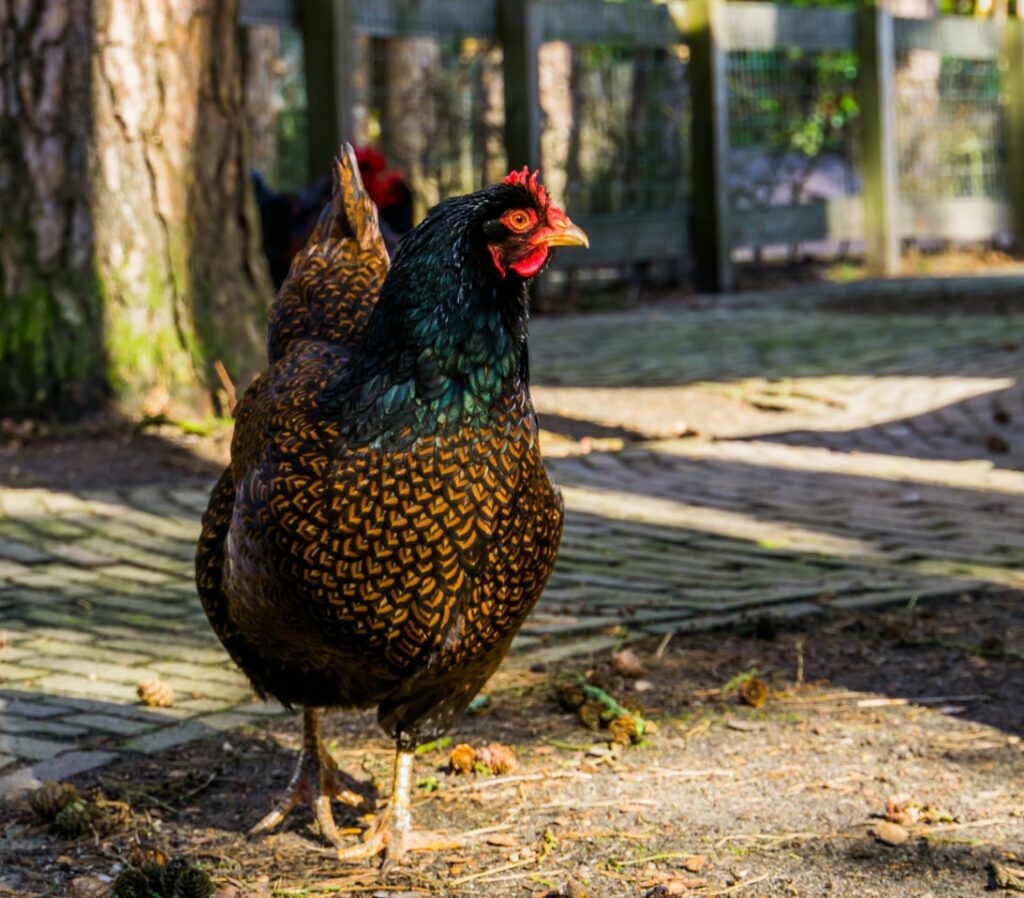
Most Barnevelder chickens have a similar appearance, which causes them to stand out from other breeds. So, let’s see what that look is and how it changes between different life stages.
What Color Eggs Do Barnevelders Lay?
Barnevelder chickens lay chocolate brown colored eggs. However, the more eggs a chicken produces, the lighter colors they’ll be. So, over time, your Barnevelder eggs might appear closer to regular brown or light brown.
Barnevelder Chick Appearance
Barnevelder chicks might vary in terms of colors, but most are fuzzy with dark brown feathers on their back and lighter feathers on their bellies. Their feathers get darker and more consistent as they age.
Barnevelder Adult Appearance
Most adult Barnevelders have what’s called a “double laced golden” color. It looks like their feathers are dark with lighter arrowhead patterns on them. This pattern occurs all over their bodies, but their necks are usually a solid dark brown color.
They have a single red comb, along with small red wattles and earlobes. Their beak and legs are usually a dark yellow color. Most keepers describe their body shape as rectangular with a U-shaped back.
Some other possible colors include white, silver, and double laced blue.
Size and Weight
Most hens weigh 5 to 6 pounds while roosters weigh between 7 and 8 pounds. So, they’re a little bit larger than the average chicken.
Breed Standard
Barnevelder chickens weren’t accepted into the Poultry Club of Great Britain until 1923. Then, the American Poultry Association didn’t recognize them until 1991.
At first, the only recognized colors were double laced and partridge. Now, each association varies based on what colors and features they accept.
Barnevelder Chicken Temperament
The Barnevelder chicken is known as a friendly, easygoing breed. Even the roosters rarely pick fights with other animals. They usually enjoy the company of humans, so they might come to greet you even if you don’t have food.
These birds are smart and curious. They love to follow you around or explore the nearby area if something seems interesting. Since they love wandering around, they are excellent birds for removing pests, such as bugs and weeds.
Broodiness
Most Barnevelder hens aren’t known for being broody, but some might want to care for their eggs and chicks more than the average chicken. It’s unlikely that broodiness will be an issue in your coop.
Noise Levels
Barnevelders are fairly talkative, but their sounds are soft, so they’re not considered “squawky.” However, they will speak up if they sense danger nearby. Thus, they’re best for keepers that don’t have other neighbors close by.
Do Barnevelder Chickens Get Along with Other Animals?
Yes, most Barnevelder chickens get along well with other animals. They’re easygoing and unlikely to pick fights, so they’ll make a good addition to any farm. Luckily, they’re also big enough that they probably won’t get picked on by more aggressive breeds.
Barnevelder Chicken Care Requirements
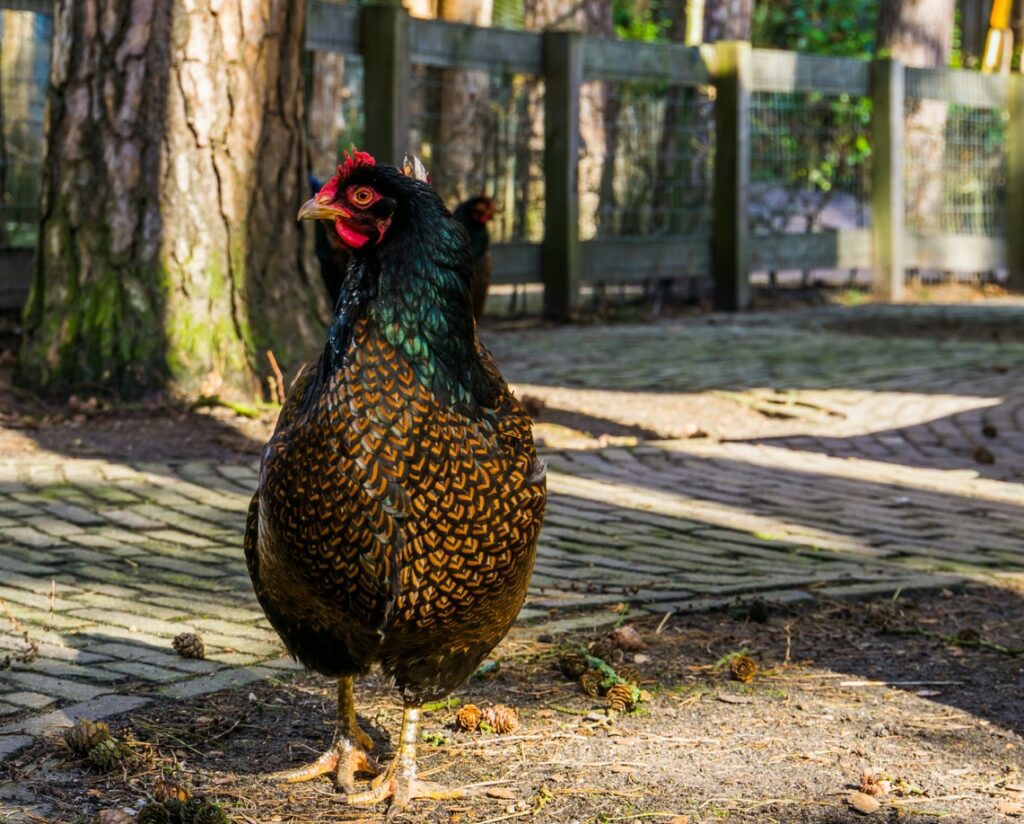
Barnevelder chickens have standard care requirements. As long as you give them plenty of food, water, and space to roam, they’ll thrive just like any other bird. Here are some specific details about their care.
Diet
As chicks, Barnevelder chickens should be given a feed with a high protein percentage. 20% to 24% protein crumbles are ideal for their first eight weeks. Then, you can slowly decrease the protein percentage. By 16 weeks old, they should be eating a feed with 16% protein instead.
However, there are some exceptions to these recommendations. Birds that are stressed or molting can eat up to 20% protein in their diets to give their metabolisms a boost. Calcium should also be provided for hens, usually in the form of an oyster shell. If hens need more calcium in their bodies, they will eat it.
Insoluble grit is an essential part of a Barnevelder chicken’s diet because it makes it easier for them to digest food. It can be offered in a separate container from their regular feed. However, if you allow your chickens to free range and forage on their own, they won’t need to rely on insoluble grit as much.
Foraging is a great way for chickens to get additional nutrients. So, consider giving them some free range time during the day. In addition to offering them proper food, make sure they always have clean water available to them as well.
Habitat Setup
Each Barnevelder chicken needs at least four square feet in the coop. Of course, you can always give them more space than that if you’re able. Since they’re a docile breed that rarely picks fights, they like to have some extra quiet space available.
In addition to coop space, each chicken should have 8 to 10 inches of roosting space. Provide several perches for roosting, and put them at varying heights. That way, the chickens have plenty of room to spread out if needed.
However, they don’t mind being extra close to each other in the winter. In the summer, they will spread out more, but in general, they don’t have personal space issues. They like the space to be available to them, but they won’t usually use all of it.
When you provide several nesting boxes for the birds, make sure they are about 12 inches by 12 inches. That way, the hens have plenty of space for nesting without being able to squeeze into the same box. Hens sharing nesting boxes puts the eggs at a higher risk of breaking.
Should You Let Them Roam?
These chickens are great free range birds because they can help control pests. They’re great at finding nutrients for their diets, which usually includes them picking up bugs and grubs. So, allowing them forage is healthy for them and your plants.
If you keep them confined, they could easily get bored. So, be sure to give them lots of space, along with things to entertain them. Leaf piles, perches, dust baths, and chicken toys are great way to keep hens occupied in a confined space.
Even if you usually keep them in a pen, it’s a good idea to let them out to forage occasionally. Constant confinement could worsen your chickens’ health by contributing to lethargy and weight gain.
Temperature
Barnevelder chickens can handle a wide range of temperatures. Yet, they prefer cold weather over hot and humid months. In the summer, make sure your chickens have access to shade and clean water at all times.
Even though these chickens are tolerant of cold temperatures, you’ll still need to provide accessible shelter to them. Depending on how extreme the weather gets, you might need to buy a coop heater to keep your flock safe.
Health Concerns
These are hearty chickens that suffer from very few health concerns. The most common issue is one that all chickens face: parasites. Chickens can easily get lice, mites, and worms if not properly cared for.
If you clean your chicken enclosure regularly, you can avoid this health concern. Replace their bedding, food, and water on a regular basis to prevent bacteria from growing. There are also some preventatives that can be used too. If one of your chickens gets a parasite, treat them right away before it spreads.
Another common illness in Barnevelder chickens is Marek’s disease. Marek’s disease is caused by a virus, but can be prevented by vaccinating your chickens.
While rare, it’s also possible for chicks to have deformed beaks. In extreme cases, this condition could prevent chickens from incubating.
How to Breed Barnevelder Chickens
When it comes to breeding chickens, you don’t have to be very involved. All you have to do is add a rooster to the coop and your chickens will do the rest. Once the hens and roosters start mating, you will eventually notice fertilized eggs in your coop.
Don’t bring roosters into the enclosure unless you want more chicks to care for. Not every chicken keeper raises chicks, and it’s perfectly fine if you only want to raise chickens for eggs to eat and sell. However, if you want to add more chickens to the coop without buying more chicks, breeding is a great way to do it.
Egg Production
Barnevelder chickens are great for egg laying. They produce about 3 to 4 eggs per week, which is about 150 to 200 eggs per year. They lay large, brown-colored eggs. The eggs are known for their chocolate brown color, but some might appear lighter.
As a bonus, the Barnevelder chicken can also lay eggs in the winter, as opposed to other breeds that slow or halt production in colder months. Thus, they’re more consistent for families looking for eggs to sell and eat.
Are Barnevelder Chickens Right for You?
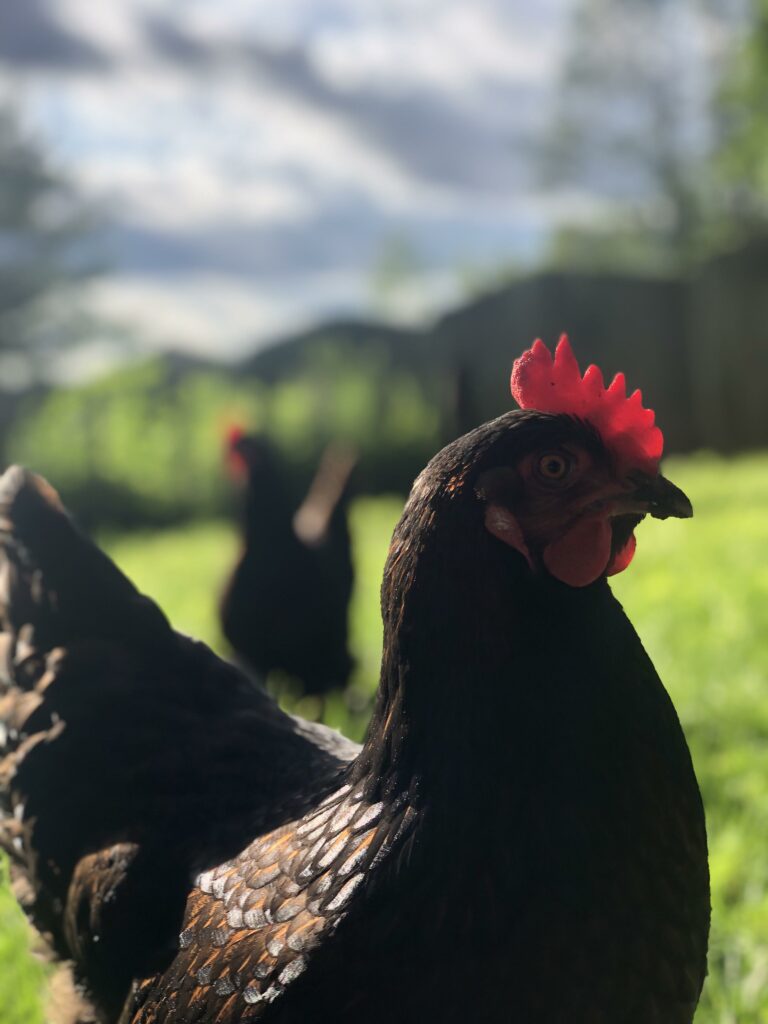
There are so many chicken breeds out there, so how do you choose which one is right for you? If you’re looking for a docile chicken that’s great for beginners, the Barnevelder chicken might be the ideal breed!
The chocolate brown eggs and the arrowhead-patterned feathers make these chickens stand out from other breeds. Those characteristics alone are enough for some people to choose them. However, it’s important to remember not to choose a chicken based on looks if you haven’t researched their care requirements first.
Overall, if you want a friendly chicken that’s great for egg-laying, then this is a good breed to choose. Yet, there are many other chicken breeds out there to consider as well, so compare a few of them before making a final decision.
